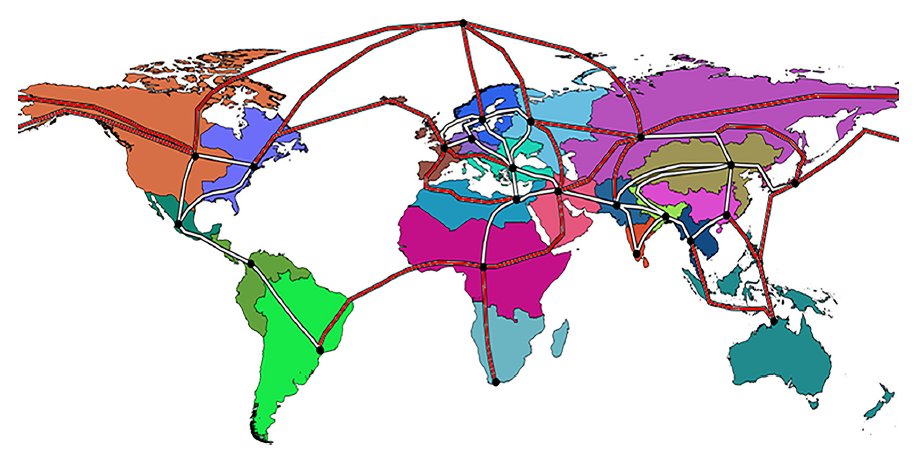From pv magazine International
The techno-economic benefits of a globally interconnected world would be lower than those provided by interconnections at the national and subnational level.
This is the main conclusion of On the Techno-economic Benefits of a Global Energy Interconnection, a new paper published by a group of researchers that includes Christian Breyer, professor of solar economy at Finland’s Lappeenranta University of Technology (LUT).
According to the study, a globally interconnected grid could offer a levelized cost of electricity of €52.50/MWh, which is 4% lower than what could be expected with an isolated global energy system. Moreover, a similar energy system would require 4% less installed capacity than a conventional one.
Renewables-based system
Solar and wind, of course, would play a central role in a globally interconnected world. “The achieved cost level of about €20-25/MWh and €25-30/MWh for solar PV and wind energy, respectively, at very good sites, brings both technologies to the forefront as a major source of energy in the 21st century,” the researchers said.
However, they believe that techno-economic analysis alone may not be sufficient to assess the advantages and disadvantages of both options. They argued that a more holistic approach will be necessary.
Energy carriers
In the future, long-distance energy trading might be done in the form of high-density energy carriers such as liquefied synthetic natural gas, synthetic liquid fuels, methanol and ammonia. “A high global granularity of geo-spatial structuring may reveal the relative range of economic benefits generated by power transmission, which may be complemented by progress in understanding future trade patterns for renewable electricity-based power-to-X fuels and chemicals and their respective transportation costs,” the group explained.
This means that the best arrangement for geospatial power sector integration from an economic perspective should be achieved on a regional level.
“A global energy interconnection may be still beneficial, but the respective electricity trade can be expected to be more within the major regions,” the researchers said.
More research
The scientists concluded that more research is needed. “I am a co-founder of the Desertec Foundation, so I still have a strong bias pro long power lines, but we have not found any long power line in the world to be really beneficial,” Breyer told pv magazine.
Last year, Breyer and his team published a study describing the advantages of a European energy system based on renewables to offer the best aspects of the energy-independent ‘prosumer nations’ and pan-continental ‘supergrids’. In that paper, the group claimed a smart grid approach – midway between a super-grid and completely decentralized energy systems – would be necessary to help Europe to achieve an energy mix based on 100% renewable energy by 2050 – an ambition outlined by Breyer in a pv magazine interview.
This content is protected by copyright and may not be reused. If you want to cooperate with us and would like to reuse some of our content, please contact: editors@pv-magazine.com.









It amuses me when decisions/ technologies are presented and then accepted or rejected on the basis of a difference of 4%… in this case.
It is simply NOT POSSIBLE to estimate “far-out” technologies and specially costs, with such precision. It just becomes a meaningless value… in fact saying … they are about the same; and should say so.
For example a “Study” was done on Electric Vehicles some years back and concluded, based on many many assumptions, that Battery Powered Vehicles were better because they were a few % points “cheaper”. I pointed out to the Author… they had “ignored” free Air Conditioning provided with Compressed Air Vehicles (CAV’s) and also the full Replacement Cost of Batteries after Five Years or even Interest Rates… TOTAL SILENCE… even after a decade. Many “swear that Battery Powered Vehicles are “Better” to Buy, Own and Operate.
The Zeppelin suffered the same “death sentence” because it was FORCED by the US Govt. to use the much much much more dangerous Hydrogen… rather than Helium (which the US had banned from Export… at that time). A great Opportunity lost by Mankind to use this very very fuel efficient solution to global travel/cruising…. and continues to date.
The Financial Community is very good at selective accepting/rejecting Technologies, they barely understand. Their decisions are normally based on the “herd mentality” as, just like herd, they cannot think for themselves and rely on others views and opinions based on such reports and situations..
In this case too… they will remember the 4% figure only… and not the assumptions behind this.
I hope and assume this article will be seen in a more “mature & balanced” light… that it really does not matter which solution you use… they are basically the same or similar.